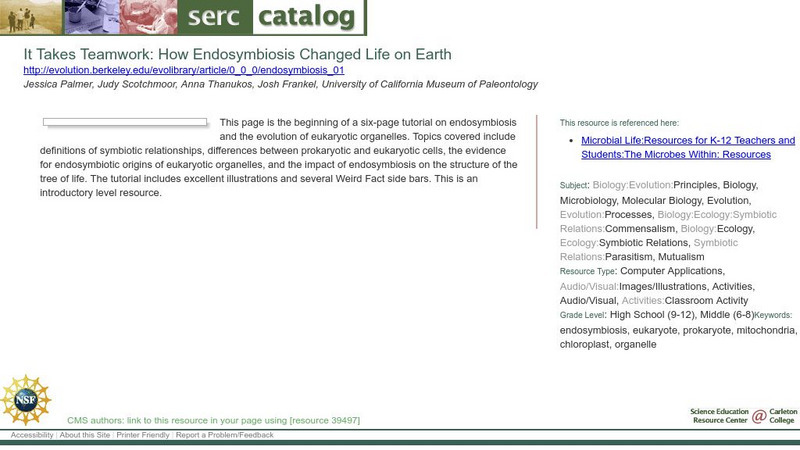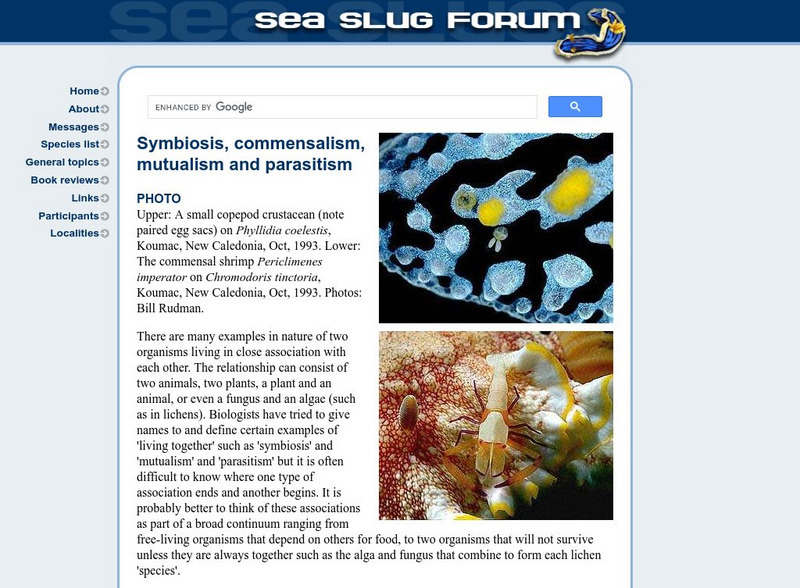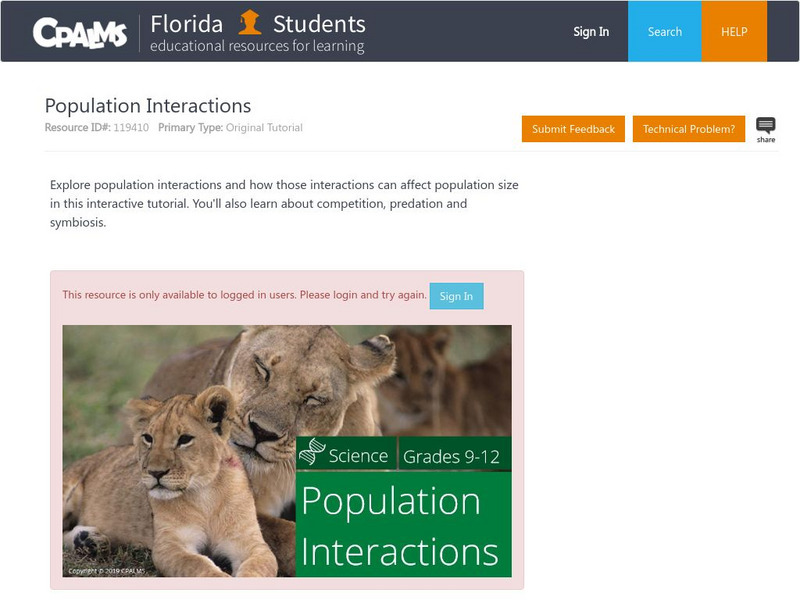Curated OER
Kingdom Fungi
In this fungi worksheet, students answer 24 questions about the fungi kingdom including the structures in fungi, the characteristics of fungi and how they reproduce.
Curated OER
Trials of Life: Living Together
For this trials for life worksheet, students fill in the charts as they watch a video. Students identify the types of symbiosis as mutualism, commensalism, parasitism, or predator-prey relationship.
Curated OER
Lesson #5: Symbiosis and Coral Anatomy
Fifth graders examine the basic structure of corals and the concept of symbiosis. They watch a Powerpoint Presentation, develop an original pair of organisms living symbiotically, and create an edible model of a coral polyp.
Curated OER
The Power of the Environment in Our Lives
Young scholars participate in a series of activities designed to demonstrate the differences between symbiotic and parasitic relationships. They discuss the differences and catergorize man's relationship with nature.
Curated OER
Ecology: Symbiosis
Eighth graders identify various types of symbiotic relationships. In this ecology lesson, 8th graders predict whether certain organisms can form symbiosis with other organisms. They discuss and defend their reasoning.
Curated OER
Fungi and Plants
In this biology worksheet, students identify and locate various vocabulary terms pertaining to fungi and plants. There are 31 biology terms located in the word search.
Curated OER
Parasites: Our Tiny Companions
Students consider parasites that seek human hosts. They prepare nutrient agar plates and cultivate samples of bacteria taken from their own bodies. They experiment with disinfectants and soaps to determine which method kills the most...
TED Talks
Ted: Ted Ed: Symbiosis: A Surprising Tale of Species Cooperation
Video explores the interdependence of two species to define the concept of symbiosis. [2:23] Followed by a short quiz and a list of additional resources to explore.
University of South Florida
Project Oceanography: Single Celled Organisms [Pdf]
For this lesson, students explore three kinds of symbiotic relationships involving unicellular organisms. They will also look more closely at the relationship between zooxanthellae and coral, and the importance of nitrogen-fixing...
Science Education Resource Center at Carleton College
Serc: It Takes Teamwork: How Endosymbiosis Changed Life on Earth
A tutorial on symbiotic relationships that explores the differences between prokaryotic and eukaryotic cells as well as the origins of eukaryotic organelles possibly being from endosymbiotic relationship. This tutorial also offers...
Encyclopedia of Earth
Encyclopedia of Earth: Evolutionary Biology: Symbiosis
Article describes the different types of symbiosis, some of which are of mutual benefit, and others not. It also explains the differences between endosymbiosis and exosymbiosis, where one organism lives either inside or else upon the...
Encyclopedia of Earth
Encyclopedia of Earth: Ecology: Lichen
Article describing the different categories of lichens, their physical features, how they reproduce, their evolution, and important benefits lichens provide to humans. (Published: July 19, 2010)
National Geographic
National Geographic: Ecological Relationships
In this lesson, students learn about different types of ecological relationships, including symbiosis, mutualism, commensalism, and parasitism. Includes handouts and a vocabulary list with definitions.
National Geographic
National Geographic: Symbiotic Relationships in Marine Ecosystems
In this lesson students analyze videos to make observations about species, populations, and communities of organisms and discuss their symbiotic relationships. Then they create a hypothetical marine ecosystem and describe the adaptive,...
Nature Conservancy
The Nature Conservancy: Coral Reefs of Palau: Nature's Amazing Underwater Cities
This instructional activity takes young scholars on a virtual field trip to the coral reefs of Palau where they will explore amazing underwater cities found near a remote network of islands in the Pacific Ocean. Learn all about an...
CK-12 Foundation
Ck 12: Episd: Symbiosis
[Free Registration/Login may be required to access all resource tools.] Identify and understand the various types of symbiotic relationships. Recognize the three primary kinds of symbiosis.
DOGO Media
Dogo News: Always Craving Cookies? Blame It on Your Gut Bacteria
Learn about how the bacteria in your digestive system influence the decisions you make about the food you eat.
NC State University
North Carolina State University: Symbiotic Relationships
Includes a description of symbiosis in general, then lists and defines types of symbiosis including mutualism, commensalism, parasitism, competition, and neutralism. Includes a chart which summarizes the different types of relationships....
Other
The Sea Slug Forum: Symbiosis and Commensalism
Question and answer site that contains a discussion of commensalism as it pertains to sea slugs. Nice photographs of aquatic commensalistic relationships.
University of Hamburg
University of Hamburg: Symbiosis & Normal Microbiota
A diagram of the different types of symbiosis. There are 4 examples of symbiotic relationships and explanations. Read this page and then give yourself a quiz.
Massachusetts Institute of Technology
Mit: Open Course Ware: Courses: Civil Environmental: Ecology I: The Earth System
College-level online course highlighting the fundamentals of ecology. Course topics include coevolution of the biosphere, geosphere, atmosphere, and hydrosphere; photosynthesis and respiration; and the carbon, nitrogen, and water cycles....
Texas Education Agency
Texas Gateway: Symbiosis
Given scenarios or illustrations, the student will determine the nature and type of relationship between organisms, including parasitism, commensalism, mutualism, and competition.
PBS
Pbs Learning Media: Sharks in Our Future
In this video segment from Nature, see the value that sharks can have on the tourism industry in an area. [1:41]
CPALMS
Florida State University Cpalms: Florida Students: Population Interactions
In this tutorial, students will study populations learning about how interactions can affect size. Tutorial explores competition, predation, and symbiosis.










![Project Oceanography: Single Celled Organisms [Pdf] Lesson Plan Project Oceanography: Single Celled Organisms [Pdf] Lesson Plan](https://d15y2dacu3jp90.cloudfront.net/images/attachment_defaults/resource/large/FPO-knovation.png)











